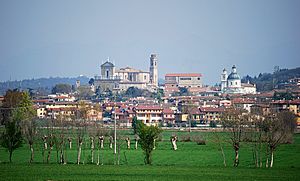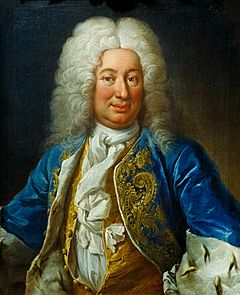Battle of Castiglione (1706) facts for kids
Quick facts for kids First Battle of Castiglione |
|||||||
|---|---|---|---|---|---|---|---|
| Part of the War of the Spanish Succession | |||||||
 View of Castiglione delle Stiviere |
|||||||
|
|||||||
| Belligerents | |||||||
| Commanders and leaders | |||||||
| Count of Médavy | Frederick of Hesse-Kassel | ||||||
| Strength | |||||||
| 12,000 | 8,000 - 10,000 | ||||||
| Casualties and losses | |||||||
| 1,000 killed or wounded | 1,500 killed or wounded 2,500 captured |
||||||
The Battle of Castiglione happened near Castiglione delle Stiviere in Lombardy, Italy. It took place on September 8, 1706. This battle was part of the War of the Spanish Succession.
In this fight, a French army of 12,000 soldiers attacked a Hessian army. The Hessians had about 10,000 troops. They were trying to capture the town of Castiglione. The French won, forcing the Hessians to retreat. The Hessians suffered heavy losses.
However, this French victory did not change the overall war. Other victories by the Imperial forces meant the French in Lombardy were trapped. Their surrender was expected soon. This led to the Convention of Milan in March 1707. This agreement allowed French troops to return home. In return, they left their remaining forts. This effectively ended the war in Northern Italy.
Why the Battle Happened
By late 1705, France and its allies controlled most of Northern Italy. They also held parts of Savoy, now in modern France. The Imperial army in Italy received many more soldiers. England and the Dutch Republic paid for 20,000 German helpers. This included 10,000 troops from Hesse-Kassel.
France's main goal for 1706 was to capture Turin. Turin was the capital of Savoy. To stop Imperial forces from helping Turin, the French attacked. They won the Battle of Calcinato in April. This pushed the Imperial forces into the Trentino valley.
By May, a French army of 48,000 men reached Turin. They began to surround the city in June. The Imperial commander, Prince Eugene, returned from Vienna. He gathered his remaining troops in the Province of Verona. He waited for more German soldiers to arrive. By July, there were 30,000 Imperial soldiers near Verona. They faced 40,000 French soldiers.
The French seemed to be in a very strong position. But they lost the Battle of Ramillies in May. Because of this, French commander Vendôme and his troops were sent to Northern France. The Siege of Turin continued. Even though the Hessian troops had not arrived yet, Prince Eugene had to act. By mid-July, he began marching to help Turin.
The new French commander in Italy was Philippe II, Duke of Orléans. He followed Prince Eugene. He left Médavy with 23,000 men. Their job was to guard the mountain passes.
The Battle of Castiglione

The Hessian soldiers finally crossed the Alps in July. They were led by Frederick of Hesse-Kassel. He later became King of Sweden. His troops arrived too late to join the march on Turin. Instead, they were told to stop Médavy from disrupting supply routes.
On August 19, Frederick sent 2,000 men to Goito. Goito was a small town with a bridge. The French soldiers there left the town. Castiglione was well-defended. The Hessians had to wait for heavy cannons from Arco. Frederick left 1,500 men outside Castiglione. The rest were near Medole. This allowed him to watch Médavy's main force at Cremona. He also watched the crossing at Goito.
The French leaving Goito was part of Médavy's plan. He wanted to gather a large army without Frederick knowing. He removed soldiers from strong places like Cremona. This let him gather 8,000 foot soldiers and 4,000 cavalry. They crossed the Oglio river at Marcaria. They attacked the Hessians on the afternoon of September 8.
Frederick had split his army, so he was outnumbered. The first French attacks were pushed back. But then, a cavalry charge led by Arthur Dillon hit the Hessian left side. The Hessians were changing positions when this happened. Their line broke apart. Médavy then attacked the Hessians outside Castiglione. Many of them surrendered. The French lost about 1,000 soldiers killed or wounded. The Hessians lost about 1,500 killed or wounded. Another 2,500 were captured.
The remaining Hessian soldiers retreated to Valeggio. Frederick wrote a letter to the Duke of Marlborough. In it, he said his forces were weak from sickness. He claimed they pushed the French back at first. But a lack of cannons forced him to retreat.
What Happened Next
Even though Médavy won, the battle did not change the war much. On September 7, Prince Eugene had broken the siege of Turin. Then he captured Milan. This left the French forces in Lombardy trapped. France could no longer afford to fight in Italy.
The victory at Castiglione slightly improved France's position for talks. But Prince Eugene's capture of Milan meant the French forts in Lombardy could not get help. Their surrender was only a matter of time.
To the anger of England and the Dutch, Emperor Joseph signed the Convention of Milan in March 1707. England and the Dutch had paid for the Imperial campaign. Victor Amadeus had also hoped to gain Milan. This agreement allowed French troops in Italy to go home freely. In return, Joseph gained the Duchy of Milan. This was important for Austria's southern borders. It also saved him the cost of capturing each French fort. This agreement ended Spanish power in Italy. It allowed Austria to take over their lands.
To make his allies happy, Joseph agreed to help. They planned an attack on the French naval base at Toulon. Capturing Toulon would give the Allies control of the western Mediterranean Sea. It would also help a Protestant revolt in Southern France. It would pull French forces away from Spain. And it would win back French-held Savoyard lands.
At the last minute, Joseph changed his mind. He ordered Count Wirich Philipp von Daun to take 8,000 troops. These troops were meant for the Toulon campaign. Instead, they captured the Spanish-ruled Kingdom of Naples. This was done by the end of September. But without a navy, the Austrians could not take the Kingdom of Sicily. This ended the fighting in Italy.
See also
 In Spanish: Batalla de Castiglione (1706) para niños
In Spanish: Batalla de Castiglione (1706) para niños

